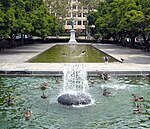Statue of John Aaron Rawlins

The statue of John Aaron Rawlins, a United States Army general who served during the Civil War and later as Secretary of War, is a focal point of Rawlins Park, a small public park in Washington, D.C.'s Foggy Bottom neighborhood. It was installed in 1874, but relocated several times between 1880 and 1931. The statue was sculpted by French-American artist Joseph A. Bailly, whose best known work is the statue of George Washington in front of Independence Hall in Philadelphia. The bronze sculpture, which rests on a granite base, is one of the city's eighteen Civil War monuments that were collectively listed on the National Register of Historic Places in 1978. The monument and park are owned and maintained by the National Park Service, a federal agency of the Interior Department. The statue is considered by historians to be one of the better portrait statues in Washington, D.C.
Excerpt from the Wikipedia article Statue of John Aaron Rawlins (License: CC BY-SA 3.0, Authors, Images).Statue of John Aaron Rawlins
18th Street Northwest, Washington
Geographical coordinates (GPS) Address External links Nearby Places Show on map
Geographical coordinates (GPS)
| Latitude | Longitude |
|---|---|
| N 38.895833 ° | E -77.041944 ° |
Address
Major General John A. Rawlins Statue
18th Street Northwest
20009 Washington
District of Columbia, United States
Open on Google Maps










